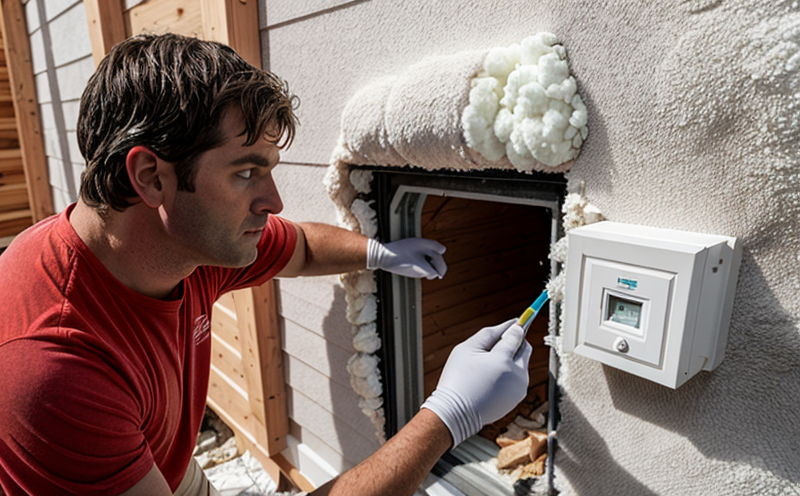ISO 6946 Thermal Resistance Calculation for Buildings
The ISO 6946 standard provides a method to calculate thermal resistance (R-value) of building materials and assemblies, which is essential for ensuring that buildings meet energy efficiency requirements. This service focuses on the precise calculation of thermal resistance using this internationally recognized standard.
Thermal resistance measures how effectively a material resists heat flow through it. In buildings, high thermal resistance is crucial to maintain optimal indoor temperatures and reduce heating and cooling costs. The ISO 6946 method allows for accurate determination of thermal resistance by considering various factors including thickness, composition, and geometry of the materials.
The process involves detailed specimen preparation and rigorous testing in a controlled environment that simulates real-world conditions. Specimens are selected based on their intended use within the building's envelope (walls, roofs, floors). The specimens undergo specific procedures to ensure they represent accurately the actual construction elements being tested.
Once prepared, these samples are subjected to standardized heating and cooling cycles in a thermal conductivity chamber. Temperature differences across the specimen are measured at regular intervals to calculate its thermal resistance. This calculation is then used by architects, engineers, and builders to design more efficient buildings that comply with international energy codes.
The results from ISO 6946 calculations play a critical role in selecting appropriate insulation materials for different climates and building types. For instance, in colder regions, higher R-values are necessary to prevent heat loss while in warmer areas lower R-values may suffice or even be advantageous depending on the design goals. Understanding these nuances allows us to tailor our services specifically to your project requirements.
Our expertise lies not only in performing these tests but also interpreting their outcomes within broader sustainability frameworks. By integrating ISO 6946 thermal resistance calculations into your building projects, you can ensure compliance with local and international standards while contributing positively towards global environmental goals.
This service extends beyond mere testing; it encompasses a comprehensive approach to understanding thermal performance in buildings. From initial consultation through final report delivery, our team works closely with clients to achieve desired outcomes that align both technically and commercially.
- International acceptance of ISO 6946 ensures consistent results globally
- The standard is widely adopted across various countries for its reliability and accuracy
- Compliance with this standard enhances the credibility of your project internationally
- Built-in flexibility accommodates diverse materials and complex assemblies
Industry Applications
The application of ISO 6946 is extensive across various sectors including residential, commercial, industrial, and public buildings. In the residential sector, ensuring proper insulation can significantly reduce heating bills for homeowners without compromising comfort levels inside their homes.
In commercial settings where space utilization efficiency is crucial, accurate thermal resistance calculations help optimize floor space usage by minimizing wasted energy due to poor insulation practices. For industrial facilities, maintaining consistent temperatures throughout large structures becomes paramount especially during manufacturing processes that require precise control over environmental conditions.
Public buildings like schools, hospitals, and government offices benefit greatly from this service as they aim to provide safe, comfortable environments for occupants while adhering strictly to energy regulations set by regulatory bodies. By leveraging ISO 6946 thermal resistance calculations early in the design phase, architects can incorporate effective strategies to enhance occupant satisfaction while reducing long-term operational costs.
Our commitment extends beyond just testing; we offer tailored solutions that consider all aspects of your project including budget constraints, timeframes, and specific performance targets. Whether you're designing a new building or upgrading existing structures, our services provide the necessary insights needed to make informed decisions that deliver tangible benefits for stakeholders involved.
Customer Impact and Satisfaction
The impact of accurate thermal resistance calculations on customers is profound. Firstly, it ensures compliance with local and international energy codes which can lead to favorable regulatory outcomes. Secondly, by enhancing the efficiency of building systems, our services contribute positively towards reducing operational costs for property owners.
Thirdly, satisfied clients report improved occupant satisfaction levels as a direct result of enhanced thermal comfort within buildings. Fourthly, this service plays an integral role in promoting sustainable practices which are increasingly becoming essential in today's world. Fifthly, it helps in achieving certification from reputable organizations such as LEED or BREEAM thereby boosting the marketability of properties.
Customer satisfaction is our priority and we strive to exceed expectations by providing reliable results within agreed timelines. We maintain a high level of professionalism throughout all stages of each project ensuring that every client receives personalized attention tailored specifically to their unique needs.





